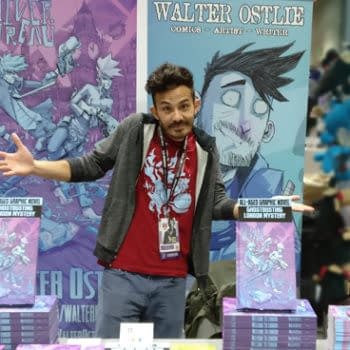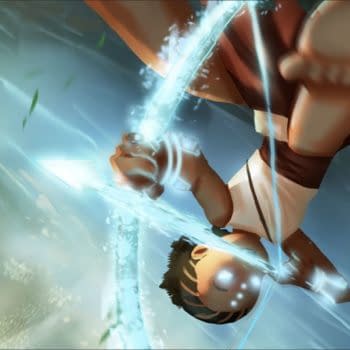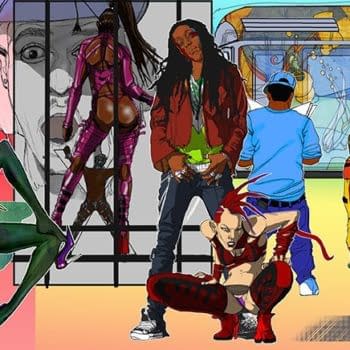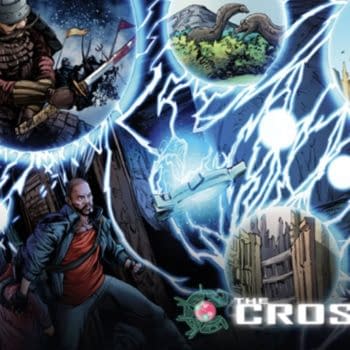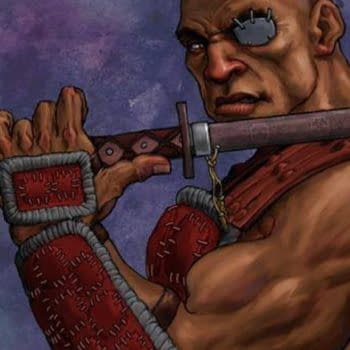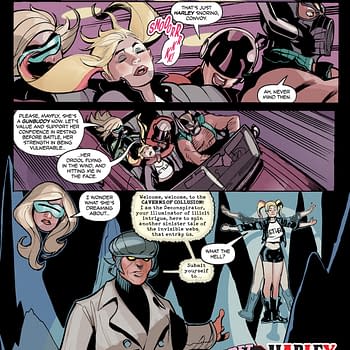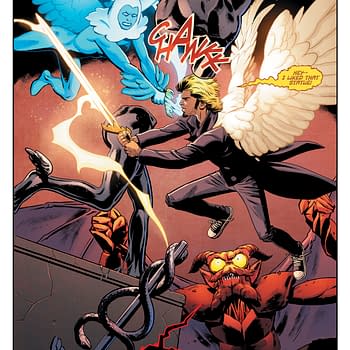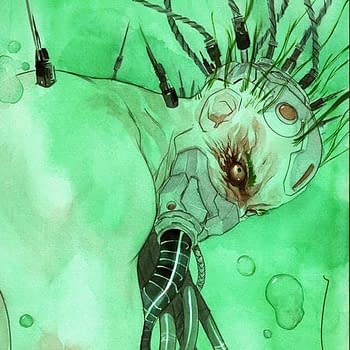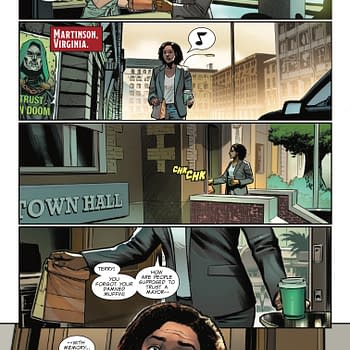Posted in: Comics | Tagged: Comics, greg anderson elysee, haxor, interview, isnana the werespider, metalshark bro, walter ostlie, webtoons
Chatting and Arting with Walter Ostlie
Walter Ostlie is a full-time comic creator, writer, and artist. He started teaching himself to write and draw in 2008 and had his first graphic novel, Cubicles, published in 2011 by Red5 Comics. After the success of Cubicles, Ostlie moved on to his sophomore project, Shiver Bureau, which raised over $13,000 on Kickstarter. Shiver Bureau was initially self-published, but it was later picked up by Scout Comics to be republished for Diamond distribution. The quality of his first two books garnered the attention of the Webtoon editorial staff. This led to the creation of Haxor, a featured Webtoon comic. His most recent project is Metalshark Bro, a "were-shark battling demons" story that raised over $50,000 on Kickstarter. Ostlie was also one of the main artists for my award-winning graphic novel comic series Is'nana: The Were-Spider. Ostlie also runs a Youtube channel where he releases video content on how to make comic books and webcomics.
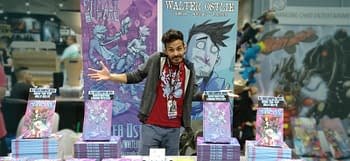
GREG ANDERSON ELYSÉE: Walter! It's good to have you, man! How have you been?
WALTER OSTLIE: I'm good. Keeping busy. Always looking for what's next and what makes sense. Just finished up Metalshark Bro: Volume 2. After I finish a big project, I fall into this idling state, and it's hard for me to want to rev up the engines again, but I think I see the light just up ahead.
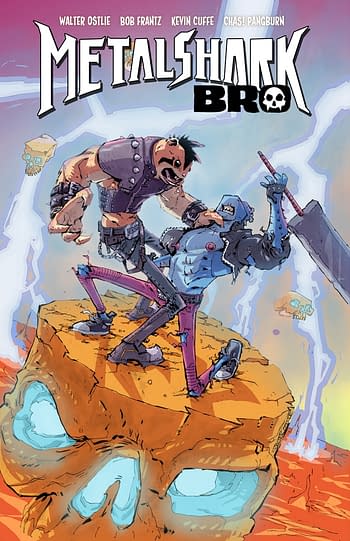
ANDERSON ELYSÉE: The light soon come, man. You and I have known each other for quite a few years now, you having drawn my first volume of my comic series, Is'nana, the Were-Spider. What have you been up to since then? You've been working nonstop, it seems!
OSTLIE: What was that 2016? I don't even know. It's all a blur.
ANDERSON ELYSÉE: [Laughs] Yeah, we released it finally in 2016.
OSTLIE: I think I was on that convention circuit trying to sell books and get the word out. It was at one of those I was introduced to Webtoon and had my comic, Haxor, picked up by them. Up next was two volumes of Metalshark Bro. So yeah, just making comics as much as possible and staying fed. I also moved three times, which made things a little crazy.
ANDERSON ELYSÉE: I understand a few years ago you decided to take the plunge from quitting your day job to work exclusively in comics. Can you tell us a bit about that decision and how that's been like since?
OSTLIE: Yeah, that stemmed from Webtoon. The schedule for Webtoon is pretty intense. They release a new episode every week. An episode equates to about 6-8 traditional American comic pages, which is nuts. That's writing, drawing, coloring, lettering. So I had to decide, do I pass on Webtoon and keep my 9to5, or do I finally take the plunge? So I took the plunge, quit my job, and started comics full time.
I'll be three years self-employed/freelance come November 2020. It's been going great. I've put out two creator-owned comics, and I've been able to make money doing it. And of course, got to work with you on the John Henry/Is'nana crossover event of the century.
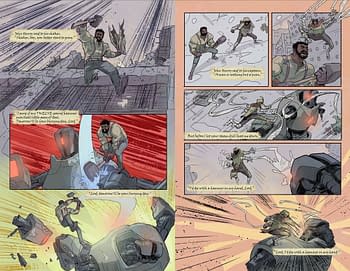
ANDERSON ELYSÉE: You know, I've had many people asking me about a follow up for that John Henry story. What are your thoughts on doing a follow-up? How's your schedule looking despite how busy you are?
OSTLIE: Was this interview a trick to get me to draw for you? ;-)
ANDERSON ELYSÉE: I meeeeaaan…. maybe?
OSTLIE: Actually, I just signed contracts for my next big project. That's going to keep me busy into 2021. I can't say much about it though, hopefully, come Summer. I'll have something to announce. But I am not sure what my schedule will look like, so I made a promise to myself not to take on any more freelance work for a year at least.
ANDERSON ELYSÉE: Man, congrats on the upcoming project! Webtoons is something I've been seeing a lot about. Many have gotten involved in it and yet still so many people in the comic business are oblivious or confused about it. From someone involved, what exactly is Webtoons, and what's been the general goal of it pertaining to comic books?
OSTLIE: Webtoon is webcomics, but like to the power of 1 million. It's a webcomic platform, like YouTube, but for comics. Anyone can make a comic, post to Webtoon, and potentially make ad revenue money. However, Webtoon is also like Netflix, in that they will fund comics. These are their "Originals." They pay the creators a publishing fee. The creators still retain their IP. It's pretty amazing. If you compare that to the traditional model in the US, Webtoon is mindblowing and a serious game changer. Haxor was one of their Originals, which is why I was able to quit my day job.

ANDERSON ELYSÉE: Well, damn! That's something I may wanna look into for sure. Now, does the structure of your storytelling change from how you usually create your work to accommodate to webcomics, or are they largely the same?
OSTLIE: Working in the Webtoon format is great. It's an infinite vertical scroll, so I have a ton of room to play with. It's a little bit of a learning experience, reprogramming everything I know about traditional comic storytelling. But the freedom is great. I could use ten panels of the same face, slowly changing the expression from confusion to horror if I wanted. Which really allows for a lot of character building.
But splash pages and wide establishing shots don't make as much sense for the format. So it's a matter of figuring out what types of panels make the most impact.
ANDERSON ELYSÉE: So traditional comics, Webtoons… How do you break down your day exactly?
OSTLIE: I work six days a week. My wife and I take off Thursday. We're both freelance. Workdays usually go… wake up at 7 am, break the fast, get to drawing around 8, draw until about 11:30, 30-minute lunch, draw till 5, and dinner. Depending on how we're feeling, we'll call it a day then, but usually, we go do some lazy work till about 8 pm. Get ready for bed and pass out around 10-11. It's an old person schedule, but I've learned not getting sleep puts my productivity into the crapper.
ANDERSON ELYSÉE: What initially inspired you to create and what keeps pushing you now?
OSTLIE: I've always wanted to create. I think all kids do and they grow out of it as they grow older. But I was always doing something—drawing, writing, poems, music. I'm not sure what's at the core of it. A lot of the time, I don't feel like I have a choice; it's just what I do. Like breathing. Not in some artistically meaningful way, but just in an everyday mundane part of what I am.
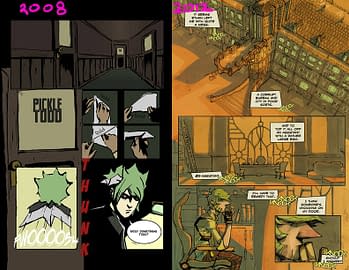
ANDERSON ELYSÉE: Can you talk a bit about your style, how you've developed it to where it's at today? I always feel like I see huge growth with each new project.
OSTLIE: Well, I'm glad you see it because I feel static lately. I've been drawing for around 12 years now. And I think I had a lot of growth in that first five years. But these last 7, I feel like I am at a standstill in regards to art skill. That being said, stuff that would have taken me a few hours to draw, I can now draw in 30 minutes. Which isn't something you can see on the surface, but behind the scenes, making art for a living it makes a huge difference.
Actually, speed may be the catalyst for my art style. I started making comics while working that 9to5, like most people. There just isn't a lot of time. So I found ways to simplify my art to make the process faster, churn out more creations. So it evolved from that.
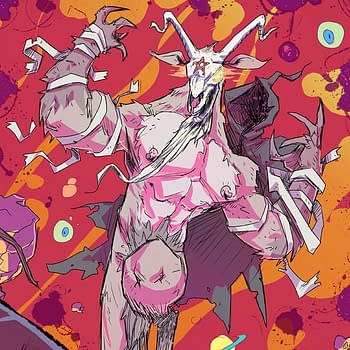
But also, all I do is draw comics, and I feel like comics are this obstacle course. You have to be good at so much stuff to be able to draw them. So instead of sitting there and drawing 100 hands to get better at drawing hands, with comics, you are still drawing those 100 hands, but you're also drawing 100 faces, poses, cars, buildings, monsters. You can't walk away from a 100-page comic without having grown in some way.
ANDERSON ELYSÉE: Very nice! Who are artists that inspired you in some way, from then to now?
Skottie Young and Ben Templesmith are the big two for me. I started as a writer and only learned to draw, so I could make my stories come to life. But all I had seen before where like Jim Lee and I didn't know if I could draw like that. Then I found Young and Templesmith, and I was like, "Whoa, you can draw differently and still have your comic at Barnes and Nobles?" And I said it just like Keanu too.
Right now, I am digging James Harren, Daniel Warren Johnson, Karl Kerschl. Of course, my favorite writer/artist of all time forever is Bryan Lee O'Malley. Scott Pilgrim rules!
ANDERSON ELYSÉE: [Laughs] I'm glad you discovered Young and Templesmith. I remember us fanboying about particular stylized comic artists when we were learning about each other to prepare for Is'nana.
OSTLIE: I grew up on Image comics, and I still love Jim Lee's art, but all I look at now is stylized art. It's just really amazing how they can take something normal, like a tree, and draw it in a way that is both familiar and uniquely alien. That's the stuff that inspires me these days.
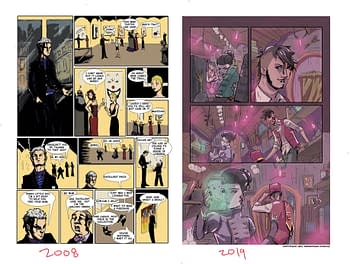
ANDERSON ELYSÉE: You've been involved on a lot of different projects. Your own work like Shiver Bureau, Cubicles, Haxor to other creators' works like mine, Is'nana, and MetalShark Bro. What pulls you to these types of quirky stories and how do you determine the styles to keep it Walter while challenging yourself at the same time? And what's been the difference exactly with them?
OSTLIE: I haven't worked with too many other creators on any extended basis. You and the writers of Metalshark Bro, Bob Fancy Frantz and Kevin Cool Guy Cuffe, are the exceptions. And in that regard, I've been really lucky. I know people have their horror stories and as much crap as I like to give you all, it's been great working with you.
As far as finding the right style, I think it starts with the writers. You wrote the story and had a vision in your head; you tracked my art down because you thought it worked with your story. And then you trusted me enough (most of the time ;-) ) to do the wacky stuff that popped into my head. So really that's on you, you choose wisely, and I just got to be me.
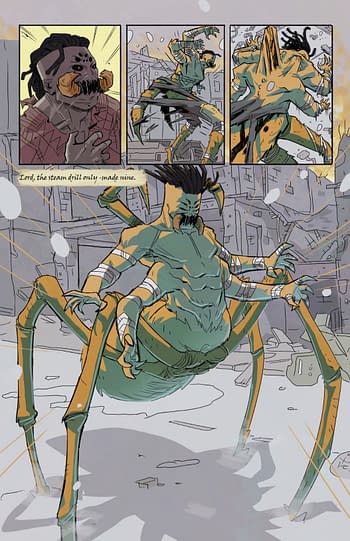
I had a conversation the other day with my wife about thumbnailing comics. I asked her, "Do you remember me getting frustrated when I thumbnailed Haxor or Shiver?" and she said no. I asked her this after having thumbnailed an issue of Metalshark Bro and being super frustrated at the end of it. And it doesn't have anything to do with bad writing, but vision and translation. When I write, I have a vision in my head, and that makes the translation to art super easy, but it's so much harder when I am trying to see the writer's vision. The most simplistic way to put is… Let's say there's a script, and it reads, "there's a box." Now, if I had written that line, I know what the box looks like, how big it is, the texture, I know the table it's on, I know the room it's in, I know if it is a cloudy day. Now, if someone else wrote it, I don't know jack squat. That's hard to draw. Working through that makes me see things in a different light, which I think makes me a stronger and more versatile artist.
ANDERSON ELYSÉE: Following that up, what's something you feel you'd like writers to know when it comes to writing and/or working with artists?
OSTLIE: I think it depends on the relationship between the two. So it's important for each creator to be comfortable talking about things. A writer needs to be okay with telling an artist that something isn't right. An artist needs to be okay with telling a writer that a scene doesn't work. And of course, each of them have to be okay with being told that. So I'd say writers should open that dialogue up and let the artist know they are okay with that type of feedback and discussion. Either the artist or the writer can bring it up, but usually, the writer is paying, so it's easier for them to bring it up.
ANDERSON ELYSÉE: Great advice. Speaking of, what the hell is MetalShark Bro anyways? That was a runaway hit and now distributed through Scout Comics.
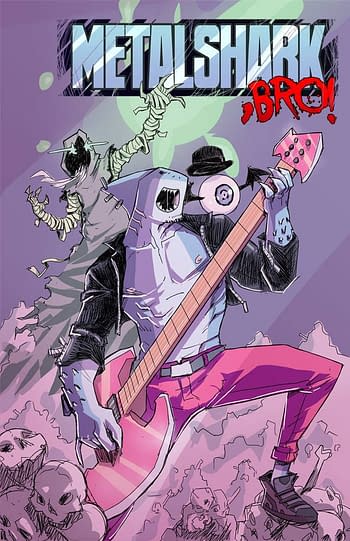
OSTLIE: I think we're still asking ourselves what MetalShark Bro is. It's a project that doesn't really make sense. We raised over $50,000 to make a story about a shark man-killing possessed donuts. It's just a fun, ridiculous story, completely stupid in all the best way. Bob Frantz and Kevin Cuffe came up with crazy stuff, and they basically gave me free reign to do whatever crazy interpretations of their visions I came up with. And it was all guided by the knowledgeable hand of Chas Pangburn, our editor, and letterer.
I think people see the name Metalshark Bro and immediately think they are gonna get some type of Bro book. Then they open up the book and just aren't ready for what it really is.
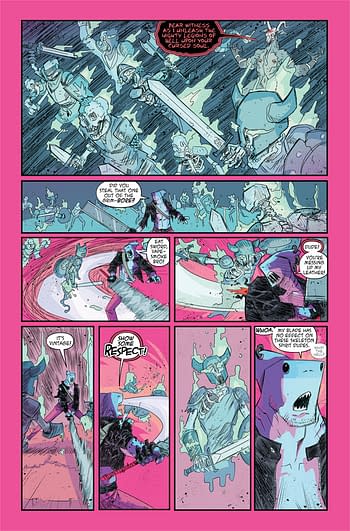
ANDERSON ELYSÉE: I had so much damn fun reading that first volume. Flew through it fast. Along with doing the art duties for Metalshark Bro, you're also currently running a Youtube channel, which – looking now! – you have 4.5k subscribers!! In your channel, you go through the makings of a comic book, from writing to drawing, lettering even, and so on. What prompted the idea to do this?
OSTLIE: After you've been making comics for a while and had even a little success, people will start asking you questions. I'm sure you know this. Usually, it's the same questions from different people. Making the videos was a way for me to say "go watch this video" and get a few pennies for my trouble.
Of course, that's kinda a joke. The other reason was to help people make comics. People are overwhelmed by the technical stuff, so I wanted to simplify that. There are people that are teaching the art side of things; I wanted to approach the technical and more mundane stuff. Take away that stress so people could focus on their stories.
ANDERSON ELYSÉE: It can be overwhelming. I'm still learning so much. You post content regularly. How do you manage it all, and how do you figure out the topics you're going to cover?
OSTLIE: That's pretty tough, actually. It causes me a lot of stress coming up with topics. It's not so much the coming up with ideas as it is figuring out how to frame it. How much detail is too much, how long should they be, is it clear? That's the tough part.
As far as managing? I've no idea really. I often feel like I'm running low on fuel, but then a comment will come through that is really thankful of the video, and that gives me a little more fuel. I also have an entire day set aside for YouTube. Try to record 2-3 videos that day to create a buffer.
ANDERSON ELYSÉE: Is'nana the Were-Spider vs. Metal Shark Bro? What would that interaction and/or fight be like?
OSTLIE: Hah. I can only dream that it would involve some kind of a magical Wonder Twins moment, and we'd have a spider-shark super kaiju monster waging war on Demons.
ANDERSON ELYSÉE: Yoooooooo!!!!!
I need more Shiver Bureau, by the way. I know you're busy with big contracts and all that, but is there hope for more of this series about ghoul hunters in an alternate England?
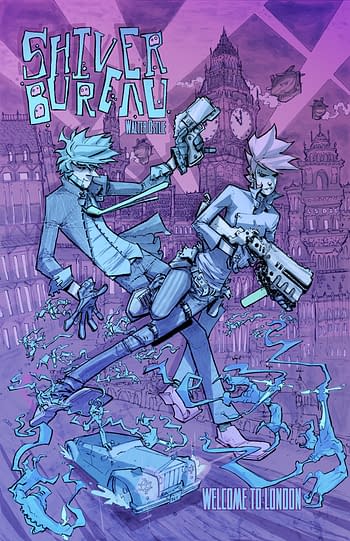
OSTLIE: God, man, I wish so hard. Maybe one day. I need to draw faster or start hiring artists. "Either you die or live long enough to see yourself become the villain."
ANDERSON ELYSÉE: Hmmm. Villainous Walter I ain't too sure would be that much different from Walter now.
OSTLIE: I'm a total sweetheart, ask anyone who's not a writer.
ANDERSON ELYSÉE: [Laughs] Where can people find your work to purchase and support?
OSTLIE: Walterostlie.com is the portal to all things me.






